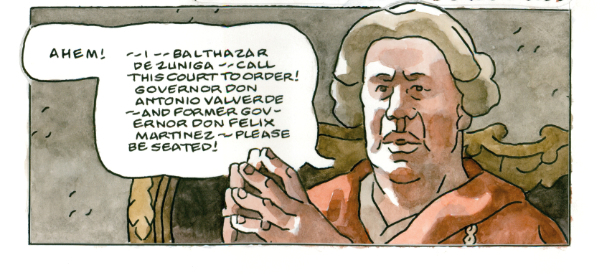History with a Grain of Salt
 Turner Avery Mark-Jacobs, DetailThe Massacre of Don Pedro Villasur, Panel No. 2 of 24, 2017. Watercolor and India ink on paper, 12 × 18 in. Collection of the New Mexico History Museum. Image courtesy of the artist.
Turner Avery Mark-Jacobs, DetailThe Massacre of Don Pedro Villasur, Panel No. 2 of 24, 2017. Watercolor and India ink on paper, 12 × 18 in. Collection of the New Mexico History Museum. Image courtesy of the artist.
By Molly Boyle
According to an old saw, history is written by the victors. But depending on who gets to create the official record, it can also be composed by the losers—or by those who weren’t even there.
When graphic novel artist Turner Avery Mark-Jacobs was invited by the New Mexico History Museum to do his own rendering of the battle depicted in the museum’s Segesser II hide painting, he sifted through multiple narratives of the ill-fated 1720 Spanish military expedition of Pedro de Villasur. Mark-Jacobs could tell, he says, “It was going to be one of those situations where you weren’t sure who to believe.”
Mark-Jacobs began drawing with the more contemporary idea that history is written by unreliable narrators. He took his organizing principle from the Akira Kurosawa film Rashomon, in which various characters give conflicting and self-serving versions of the same event. Mark-Jacobs applies the “Rashomon effect” to his twenty-four-panel exhibition The Massacre of Don Pedro Villasur, on long-term display across from the hide paintings in the museum’s Segesser Gallery. The exhibition explores the shifting perspectives on Villasur’s fate in three acts. Its story is set in a courtroom at the Palace of the Governors, where different characters testify to the events of the massacre.

Some facts of the case are indisputable: At dawn on Aug. 14, 1720, at the confluence of the Platte and Loup rivers in present-day Nebraska, Villasur and nearly forty of his men were killed at dawn by a group of Pawnee and Otoe. The expedition had been dispatched by Spanish interim governor Antonio Valverde y Cosío to gather intelligence on French colonists moving into territory claimed by Spain.
The museum’s Segesser II painting tells that story, but adds an extra element: Thirty-seven Frenchmen in tri-cornered hats who fire muskets at the Spanish contingent. This addition muddies the record, suggesting that the French joined forces with Plains Indians to decimate Villasur’s contingent. Historians speculate that the hide painting was created by Spanish artists who added this bit of propaganda to bolster Valverde’s claim that the attack was instigated by the French. “The hide paintings reflect a very specific version that comes from the government of New Mexico,” Mark-Jacobs affirms.
No one knows the origin of the tale the hide tells. That ambiguity freed up the interpretations in The Massacre of Don Pedro Villasur. Stylistically, the hide painting and the graphic novel couldn’t be farther apart, but Mark-Jacobs sees the two works on a continuum.
“Those hide paintings are a form of comic-book storytelling,” he says, speculating about the influences that drove the hide artists. For his part, he has long been attached to the clean lines in Hergé’s The Adventures of Tintin. He also studied the red and brown palette of Diego Velázquez paintings and watched Werner Herzog’s Aguirre, the Wrath of God to capture a Spanish Colonial feel.
As an interpretive tool, The Massacre of Don Pedro Villasur goes far beyond the flat drone of museum text panels. It reminds us that history is more colorful, thought-provoking, and (dare we say) accurate when its narrators are put on trial.
—
Molly Boyle is a writer and editor living in Northern New Mexico. She writes a column on Southwestern literature for the Santa Fe Reporter.
